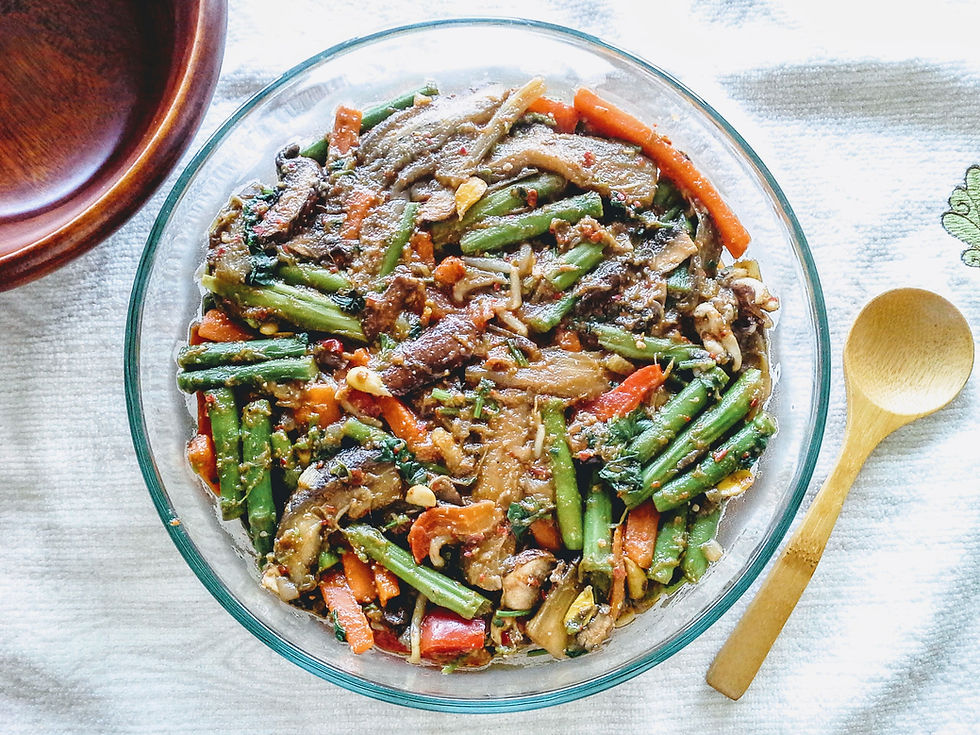One-Pot Bibimbap for a Busy Cook
- Jung-Eun Lee

- May 20, 2017
- 4 min read
Updated: Mar 3, 2023
Do you love the heat and the surprisingly complex flavors from many ingredients of bibimbap?
If you have ordered bibimbap at a Korean restaurant, fallen in love with it, and looked up its recipes online, most of them may not have been inviting enough for you to try out.
It is not your fault. Traditional Korean recipes require that you cook individual ingredients one by one, serving them over rice with a Korean red chili paste called gochujang. It means a major investment in your cooking time.
I love shortcuts to complicated procedures. It is my thing to figure them out. Perhaps it is coming from my long-time training as a biochemist.
The beauty of this recipe is that you have total control over which ingredients to use as long as you stick to the secret sauce-gochujang. Don't worry if you don't have gochujang. I will give you an easy recipe for it.
Are you ready to cook your own simple version of bibimbap?

Ingredients for 4-6 servings
Half a sweet onion (thinly sliced)
One medium carrot (julienned)
One pound of asparagus or spinach (cut into 2-inch sticks)
One medium zucchini (thinly sliced in half-moon shapes, salted, and drained)
Half pound of baby portabello mushrooms (sliced; you can also use Shiitake mushrooms instead)
4 sticks of celery (finely chopped)
A quarter-pound of seafood mixture (chopped squid, chopped octopus, scallops, mussels, and shrimps; you can buy a package of uncooked, snap-frozen seafood mixture at any Asian grocery market.)
Cooked rice
Korean red chili sauce that mimics gochujang
2-3 tsp of Korean red pepper powder. It is important to use coarsely ground red pepper for gochujang (see the picture below for an example). You can keep it in the refrigerator for a long time.
1 tsp of fermented soy sauce. My favorite is Sempio naturally brewed soy sauce (see its picture below). Fermented soy sauce has layers of deep flavors that chemically produced soy sauce (most soy sauces belong to this category) does not have. Please make sure to read the label before purchasing a bottle of soy sauce. Wondering about its shelf-life? Because it is too salty, microbes cannot grow in it. I keep it on the shelf for over a year.
1 tsp of sesame oil
1 tsp of finely chopped garlic
1 tsp of ginger powder
1 Tsp of water
Instruction
The first thing to do is to prepare for zucchini. You will need to remove excess water from it by salting and draining it ahead of time. Without this step, you can easily end up with a soupy stir-fry. Who wants that? Cut a zucchini lengthwise first and slice each half piece thinly in half-moon shapes. Set up a colander over an empty bowl and put the half-moon zucchini in the colander. Add half a teaspoon of salt to the sliced zucchini and mix it well. Due to the osmosis, water will come out of the zucchini and be collected into the bowl below the colander.
While waiting for the zucchini to become dehydrated, you can make the red chili sauce by mixing all the listed ingredients above in a small mixing bowl and set it aside.
Next, you should defrost the seafood mixture by taking a portion out of the package and immersing it in water. Now it is time to cut all the other vegetables as specified above.
If you are done with chopping and slicing, you are ready to roll now. Heat a stir-fry pan over medium-high heat with two teaspoons of canola oil on the pan.
Once the pan is hot enough, stir-fry the sliced onion first. When they become somewhat translucent, add the julienned carrots to the pan. Stir-fry them for a minute or so. Now add the sliced asparagus and the drained zucchini half-moons to the pan. Sprinkle half a teaspoon of salt over the vegetable mixture, mix everything well, and cover the pan. Lower the heat to the medium level and let the water coming out of the vegetables steam them for three minutes.
While steaming the vegetables in the pan, rinse and drain the seafood mixture to remove excess water from it. Without this step, you will end up with a soupy stir-fry.
Open the lid and raise the heat to the medium-high level. Add the sliced mushrooms, the chopped celery, and half a teaspoon of salt to the vegetable mixture in the pan. Stir-fry it until the mushrooms become cooked down and add the seafood mixture to the pan. Continue to stir-fry everything for one or two minutes until shrimps turn pink. Turn off the heat, add the red chili sauce to the pan, and mix everything well. Season the final mixture with salt and pepper to your taste.

Place a portion of cooked rice in a deep serving bowl and serve the vegetable/seafood mixture over rice. Then, mix them well in a bowl. Voila! You got yourself bibimbap.
By now, you may have noticed that I did not use the traditional bibimbap ingredients (spinach, bean sprouts, fern brakes, fried eggs) in this recipe. You can certainly use them if you don't mind batches of cooking and cleaning the pan several times between batches.
I often recycle any leftover vegetables to make bibimbap. Every time, it turned out to be delicious. The possibilities are endless. Let me know how you make your own version of bibimbap in the comment below. For other one-pot meal ideas, you can check out the following recipes: Mexican bibimbap, kimchi rice, spicy cauliflower over rice, sweet potato noodles, savory rice cakes, Pad Thai, and curry.







Comments